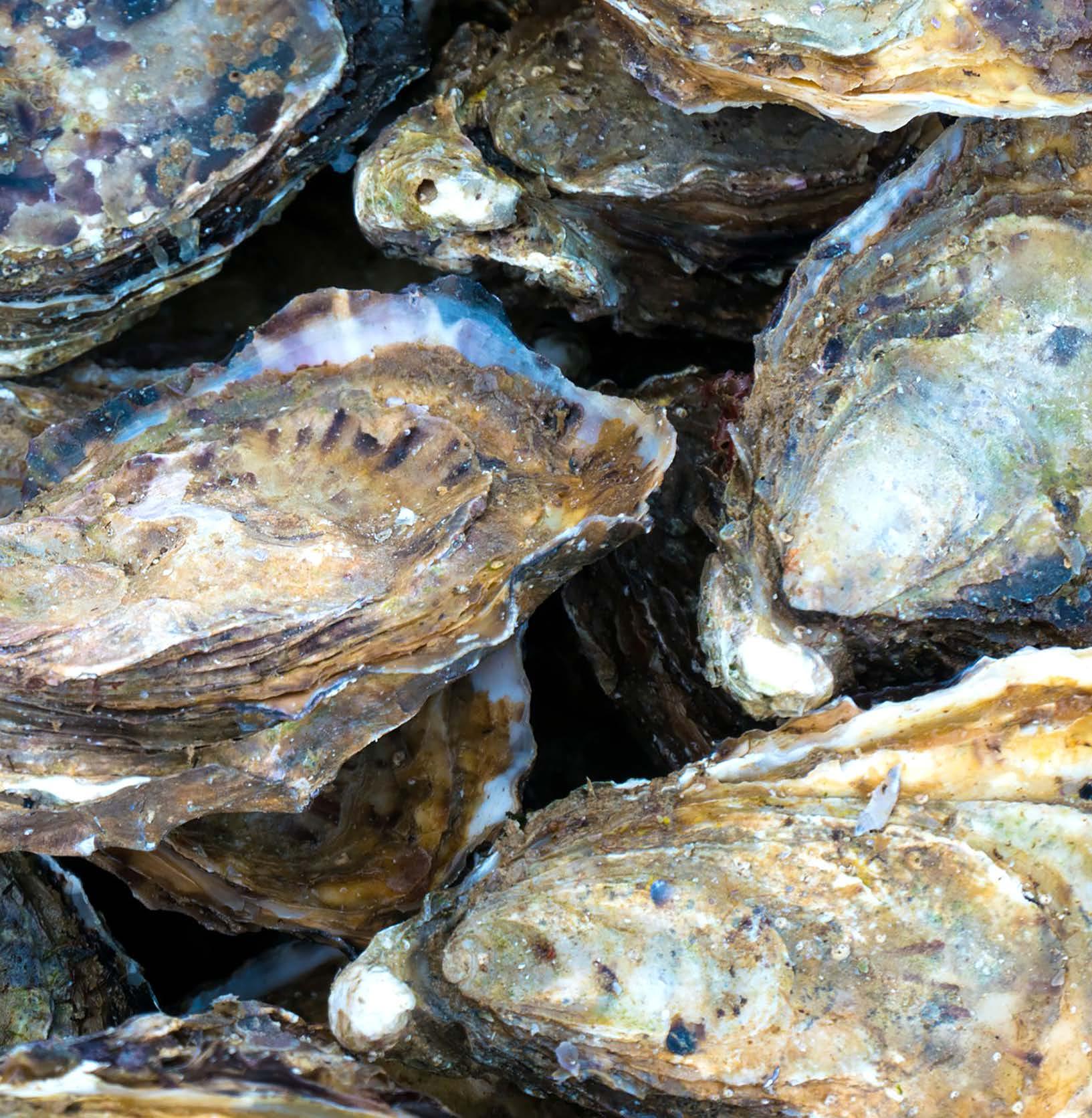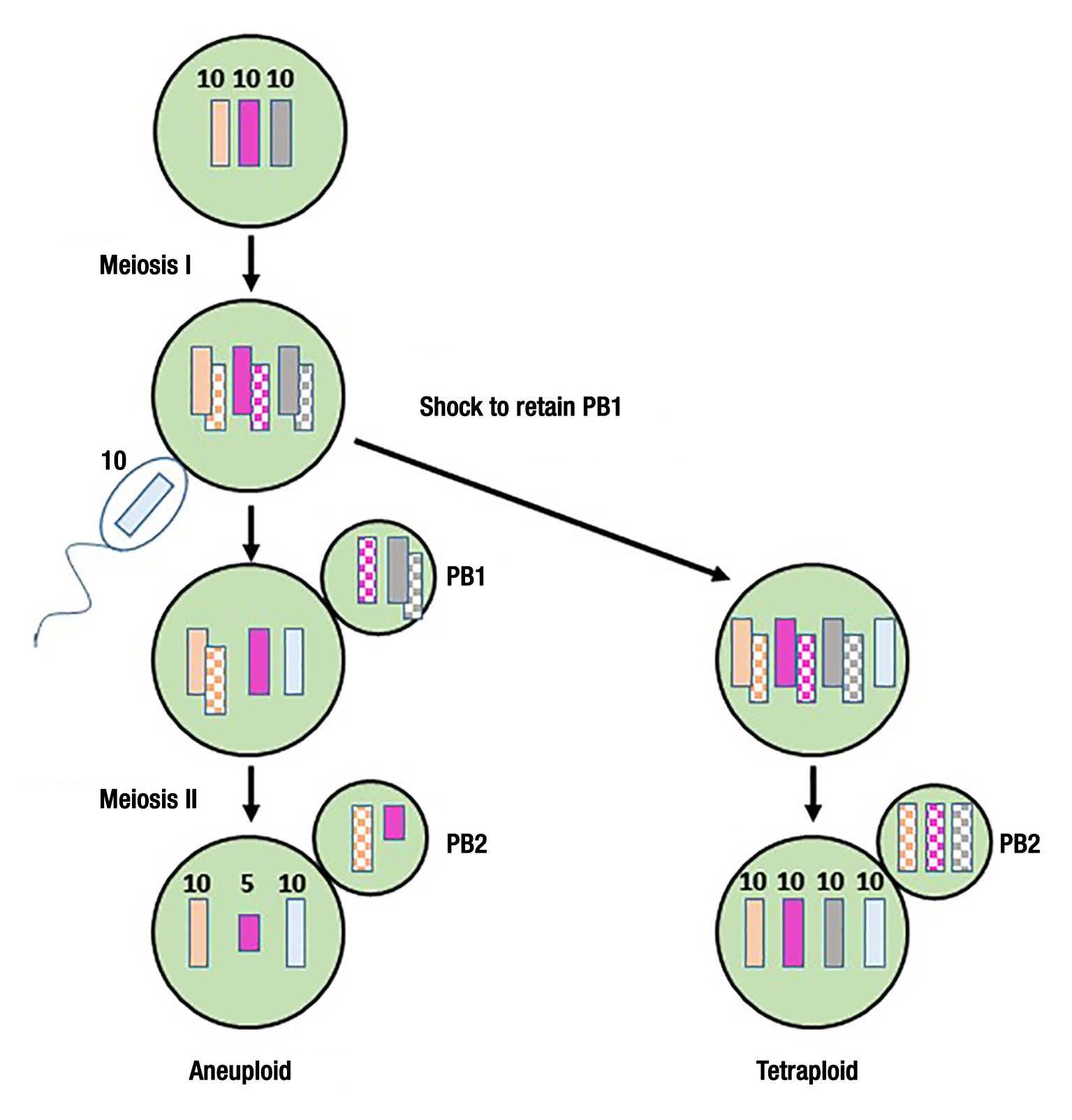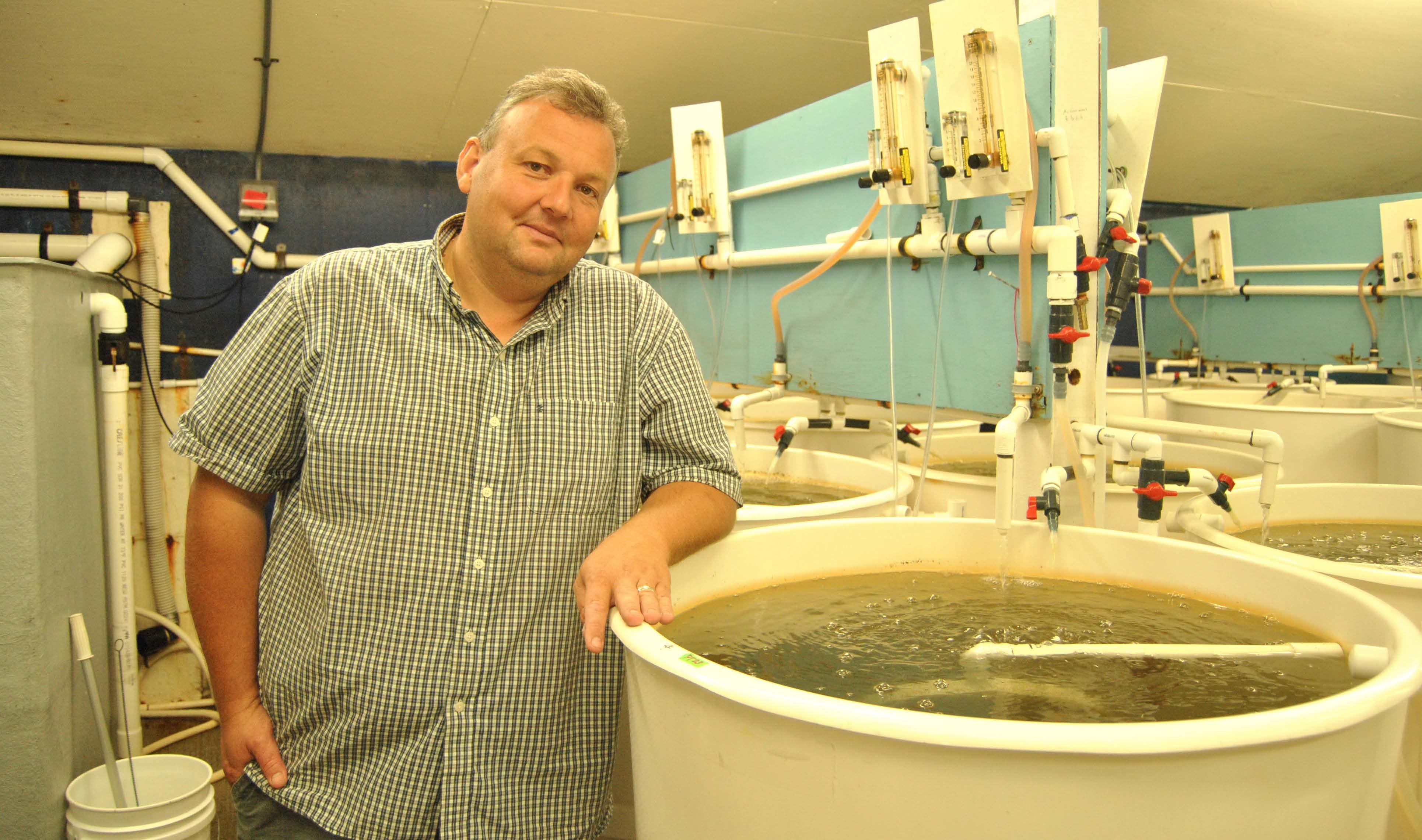
8 minute read
THE SHELLFISH CORNER
Using Cytogenetics to Domesticate Oysters and other Shellfish
By Michael A. Rice*
One of the key problems faced by oyster farmers in temperate regions of the world is that the condition of the oysters, or the relative ‘fatness’ of the meat, changes throughout the growing season in response to changes in water temperature and the seasonal availability of phytoplankton in the water as food for the oysters.
During boreal or austral springtime periods, water temperatures are on the rise and day length is increasing. In combination this causes blooming of phytoplankton populations and a greater filter-feeding response by the shellfish. The result of all this springtime food availability and feeding by oysters results in maturation of their gonads and storage of glycogen, a complex carbohydrate acting to chemically store energy within the oyster tissues. During the late springtime just prior to spawning oysters are the ‘fattest’ with gonads that are ripe and stored glycogen is at a maximum. It is during this time that oysters are the most flavorful and desirable from a marketing standpoint. However, once the oysters spawn during the early summer, the gonads become spent and much of the slightly sweet glycogen is depleted by fueling the spawning process. It is during this time that oyster meats become the thinnest and least desirable by knowledgeable oyster aficionados, often leading to a seasonal depression in market prices.
Cytogenetics, or the manipulation of the numbers of chromosomes carried by a plant or animal, has been a way to produce oysters that are faster growing and avoid summer thinning of the soft tissues. Animals like humans or oysters (and most plants) are typically diploid, carrying two sets of chromosomes. Oysters and many other bivalves carry 10 pairs of chromosomes in the diploid state, in comparison to the 23 pairs in humans. One chromosome set comes from the mother through haploid egg cells, and the other set from paternal haploid sperm cells, with the diploid state being reconstituted upon fertilization and formation of a diploid embryo. However on occasion, organisms can be induced to carry one or more ex
tra sets of chromosomes in a state called polyploidy. Polyploid organisms with three sets of chromosomes are known as triploids, and those with four sets are known as tetraploids.
Often times, polyploid organisms express polyploid gigantism by growing faster and attaining larger sizes than their diploid counterparts. For instance induction of polyploidy is a frequent practice among plant breeders to create larger fruits, flowers and seeds. Various cultivars of chrysanthemums, for example, may be produced in various polyploid states that have flowers that are much larger than their diploid cousins. Domesticated diploid Einkorn wheat is much more like the wild type wheat from the Middle East, but Durham wheat that is a source for couscous and pasta flour is tetraploid, and common bread wheat with extra-large starchy seeds are hexaploid, carrying six chromosome sets. Agronomists will

induce polyploidy in a wide range of crops to induce seedless varieties (e.g. grapes, watermelons and bananas) or to increase crop yields. It is important to emphasize that cytogenetic manipulation of chromosomes is not genetic engineering, or as it is often called genetic modification (GM), in which there is gene editing by deletion or insertion of genes from other organisms. Cytogenetic manipulation simply duplicates the existing genetic material in the chromosomes.
Organisms carrying odd numbers of chromosomes, such as triploids, are often infertile with very little capacity for producing offspring, and this is the basis of seedless varieties of plants. In the early 1980s, the first to investigate the induction of triploidy in oysters and soft-shell clams was Dr. Standish K. Allen of the Virginia Institute of Marine Sciences, along with colleagues, when he was a graduate student at the University of Maine’s Darling Marine Research Center [See: Stanley et al. (1981). Aquaculture 23:1-10; Allen et al. (1982) J. Hered. 73:421-428]. His rationale for producing triploid oysters was to potentially prevent oysters from spawning as is done in the seedless fruits, thereby preventing oysters from spawning and thinning out during the summer season, thus preserving their tasty springtime qualities. Stored energy in the form of glycogen could also be directed away from fueling gonad maturation toward the growth of somatic or non-gonadal tissues (Figure 1). Subsequent studies over the last three decades on many species of molluscan shellfish have shown that triploidy can be induced and there is usually a resultant increment in growth performance. A recent meta-analysis of 29 published studies of growth of diploid and triploid oysters has shown that in 126 out of 148 independent experiments, or 85%, triploids outperformed diploid oysters in terms of size and weight gain [See: Wadsworth et al. (2019). Aquaculture 499:9-16].
Although the pioneering work on triploid shellfish was done in Maine, the commercialization of the hatchery production of triploid oysters occurred when Stan Allen moved on to the University of Washington (UW) for Ph.D. studies in the laboratory of Dr. Kenneth Chew (who also served for many years as the shellfish aquaculture columnist for Aquaculture Magazine). Allen collaborated with personnel from a large scale commercial oyster hatchery in Washington to produce triploid Pacific oysters. For nearly 20 years, the mode of production of triploid shellfish developed by Allen consisted of using an alkaloid toxin derived from a fungus (cytochalasin-B or CB) that acted chemically to disrupt the separation and sorting of chromosomes during the process of meiosis. CB acts to prevent the expulsion of excess genetic material from single cell oyster embryos (in a process known as polar body formation) after the haploid sperm cells deliver their haploid chromosomes into the egg cells during fertilization (Figure 2). This retention of genetic material in the single-cell oyster embryo after fertilization is the basis for the formation of what are known as chemical triploids. The problem with CB is that it is difficult to work with in the hatchery and the U.S. Food and
Drug Administration regulatory authorities were always a bit wary about its use in individual organisms eventually destined for direct human consumption, even though it would be completely cleared out of the oysters at least two years before they would ever be consumed. CB is known to cause cellular mutations in humans. A major technological breakthrough in the production of triploid oysters happened in the mid-1990s after Dr. Allen joined the research faculty at Rutgers University Haskin Shellfish Research Laboratory near Port Norris, New Jersey. Dr. Allen invited Dr. Ximing Guo, a post-doctoral fellow just finishing up his tenure in Dr. Chew’s Laboratory at UW to join him in New Jersey, and the two of them set out to solve the problem of how to reliably produce triploid oysters without CB being used on oyster embryos destined for consumption. The idea they pursued was to create fertile tetraploid oysters that could be crossed with regular diploid oysters that would yield mostly sterile triploid oysters as their offspring.
These offspring triploids from the diploid and tetraploid cross would have never been directly treated by CB. The trick was how to produce the tetraploid parental stock. What they were able to figure out is that if CB was used to inhibit first polar body formation after haploid sperm fertilization of rare triploid eggs

Figure 1. A comparison of diploid and triploid oysters. Photo courtesy of Louisiana Sea Grant College Program.

Figure 3. Production of tetraploid oyster embryos pioneered by X. Guo and S. Allen. Rare triploid oyster eggs with 3 x10 chromosomes are fertilized by a haploid sperm cell, and cytochalasin-B (CB) is used to inhibit the first polar body formation. Without CB, the regular meiotic processes proceed uninhibited, creating the aneuploid state that are partially triploid and usually not viable.

from triploid parental stock, then tetraploids would be formed [See: Guo & Allen (1994) Mol. Mar. Biotechnology 3:42-50]. A viable tetraploid embryo produced by this process would proceed forward and develop into a fertile adult tetraploid oyster. These tetraploid oysters could then be crossed with normal diploid oyster stock to produce the mostly infertile triploids [See: Guo et al. (1996). Aquaculture 142:149-161]. However it is important to note that this process of establishing a founder parental line of tetraploid oysters for producing triploid offspring is very
difficult, and takes plenty of patience. But once a founder line of tetraploid oysters is established, it is fairly easy to maintain the genetic line because of the fertile nature of oysters carrying even numbers of chromosomes (as the tetraploids do).
Soon after the process to produce tetraploid oysters was perfected, Rutgers University applied for a patent for the process, naming Guo and Allen as the inventors. They were issued patent US5824841A in October 1998, with an expiration date of 21 January 2014 [See: https://patents. google.com/patent/US5824841A/ en]. This technology for producing triploid oysters from crosses of tetraploids and diploids has transformed the hatchery production of oysters, primarily in the West Coast of the United States as well as in France and Australia. Now that the patent is expired, the tetraploid shellfish technology is likely to spread even further, and include research and development of specialized strains of triploid oysters adapted for disease resistance or for better performance in oyster restoration projects, or in marginal habitat areas. Since tetraploid parental stock are fertile, they can be constantly improved through selective breeding programs similar to those used for development of traditional diploid strains and used to produce improved triploid offspring.

Michael A. Rice, PhD, is a Professor of Fisheries, Animal and Veterinary Science at the University of Rhode Island. He has published extensively in the areas of physiological ecology of mollusks, shellfishery management, molluscan aquaculture, and aquaculture in international development. He has served as Chairperson of his department at the University of Rhode Island, and as an elected member of the Rhode Island House of Representatives. rice@uri.edu







